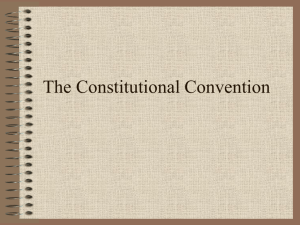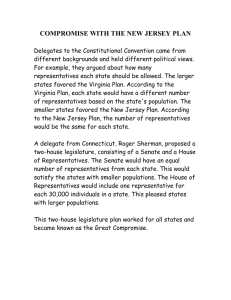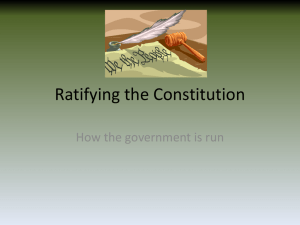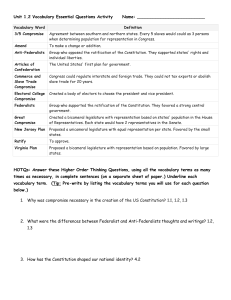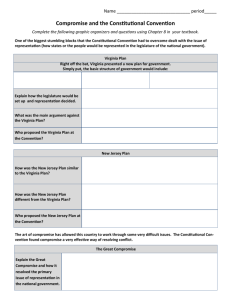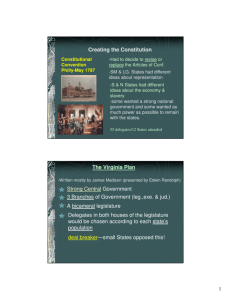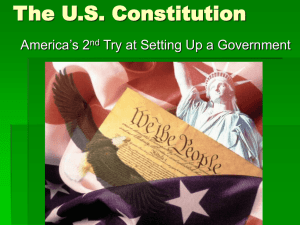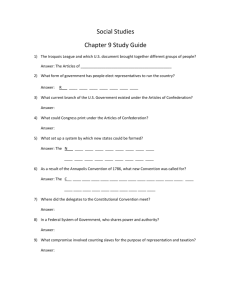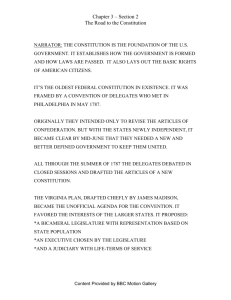Constitutional Convention
advertisement
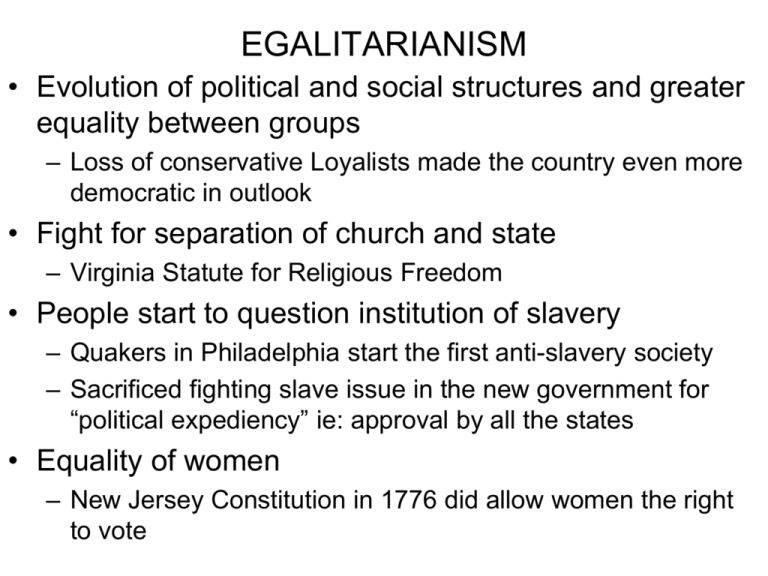
EGALITARIANISM • Evolution of political and social structures and greater equality between groups – Loss of conservative Loyalists made the country even more democratic in outlook • Fight for separation of church and state – Virginia Statute for Religious Freedom • People start to question institution of slavery – Quakers in Philadelphia start the first anti-slavery society – Sacrificed fighting slave issue in the new government for “political expediency” ie: approval by all the states • Equality of women – New Jersey Constitution in 1776 did allow women the right to vote • Civic Virtue – The concept that democracy depended on the unselfish commitment of each citizen to the public good • Mothers became the ones who train next generation in moral education • Republican Motherhood – “Women become the “keepers of the nation’s consciousness” • Became important to educate women who were going to train the future generations REPUBLICAN IDEOLOGY COMMON FEATURES – EARLY STATE CONSTITUTIONS • State constitutions were contracts that defined the powers of government and drew authority from the people • Written documents • Fundamental law – not legislation that can change • Bills of Rights included in most • Annual election of legislators who stay in touch with the needs of the people • Weak executive and judicial branches of government • Legislature presumed the most democratic branch ECONOMIC CHANGES IN COUNTRY • Loyalist lands confiscated and broken up into smaller farms – Increased economic democracy as more people became landowners – Also led to political democracy as those landowners now became involved in the political process • Manufacturing started to develop as America cut off from British markets – American ships barred from British and West Indies trade – Move into the Asian markets • Problems with debt and threat of economic turmoil SPECTER OF ANARCHY • States refused to pay money to central government • Quarrels over boundary disputes between states • Some states charged other states duty on products being shipped in for sale • Civic virtue seemed not enough to control selfinterest and greed – Conservatives want to safeguard wealth and position – But those who owed debt did not want a stronger government that would force repayment • Shay’s rebellion scared many into pushing for a strong government • Differences on how to strengthen the government to avoid anarchy yet not give up states’ rights issues CONSTITUTIONAL CONVENTION OF 1787 • Control of commerce and interstate fighting issue that finally pushed many to meet • Meeting held in Philadelphia • The original purpose of the meeting was to revise the Articles of Confederation • The representatives included original rebels as well as a new generation of younger statesmen starting to have influence in the development of the country – Benjamin Franklin was the oldest member at age 81 – New people like Alexander Hamilton and James Madison – John Adams, Thomas Jefferson, Patrick Henry not there • George Washington agreed to be president of the Convention • His being involved showed how important the convention was to the country • His presence kept more radical elements under control • George Washington's life mask was made in 1785 by French sculptor Jean Antoine Houdon when Washington was fifty-three • The life mask shows Washington as he really appeared in life http://www.earlyamerica.com/review/spring97/washington.html JAMES MADISON • He was born in Virginia in 1751 • But, attended college in the north, at Princeton University • A member of the Continental Congress and the Virginia Assembly • Represented Virginia at the Constitutional Convention • Considered one of the most educated, intelligent men of his era • Madison prepared for the meeting by reading books on theory, history and development – Many of the books had been sent to him by his friend, Thomas Jefferson, who was then Ambassador to France • He took notes during all meeting sessions – Historical documents of the proceedings that still exist and are used to review the history of constitutional development • His ideas on government structure and democracy had a strong influence on the other delegates • He was the author of the Bill of Rights (first 10 amendments to the Constitution) • He wrote 29 of the Federalist Papers, defending the development of a new, federal government SECRET MEETINGS • The meetings were held in secrecy so no one would find out in advance about the details of the discussion • This allowed members to make decisions without worrying about public opinion • Members soon realized they were creating a new government, not trying to salvage the old Articles • Members assigned to be with Franklin, who talked too much TWO LEGISLATIVE PLANS DEVELOPED • Many recognized the need for a stronger federal government structure with a more organized, more representative legislature • Need for an executive leader and an impartial judicial also major concerns • Two major plans on the structure of the new legislature and government organization developed: – The New Jersey Plan – the “small state” plan – The Virginia Plan – the “large state” plan THE VIRGINIA PLAN • Proposed by James Madison &Edmund Randolph • Three branches of government • Two houses in the legislature • Members selected for each house based on the amount of population within the state • One vote per representative • With this plan, larger states would have more power in the legislature because they would have more representation • Proposed by William Patterson • Three branches of government • One house in the legislature • Members selected by the states • But, only one vote per state • With this plan, small states have as much power in the legislature as larger states THE NEW JERSEY PLAN • Small states feared domination by the large states in the legislature • Large states angry at having to always negotiate with small states for their vote – And, they were not being represented based on population • Roger Sherman of Connecticut developed a compromise between the New Jersey and Virginia plans • He proposed a legislature made up of two separate houses THE GREAT COMPROMISE • The “Lower House” would be a House of Representatives – The number of members from each state based on the population of the state – So large states have more members – One vote per each member • The “Upper House” would be a Senate – Two members per each state, no matter the size of the state – So smaller states have equal representation – One vote per each member • To ensure equity and balance of power between the two houses: Any legislation / bills being processed must have the approval of both houses before it can be forwarded and made into law SOUTHERN STATES AND REPRESENTATION • Southern states with smaller white populations worried about losing influence, especially in the House of Representatives • They wanted to count their slaves as population so they could have more representation in Congress • Northerners objected because: – There were many more slaves in the South than the North, giving the South an unfair advantage in the counting – Slaves were not allowed to vote, and by some southerners considered property, so why should the South be allowed to count slaves as population for this reason? THREE-FIFTHS (3/5) COMPROMISE • The convention compromised so Southern states would approve the new Constitution • The Compromise allowed 3 of every 5 persons of the entire slave population to be counted for representation – This rule also applied in the North • It gave southern states a larger representation in the House of Representatives • Use a census to verify the population of the country – Update the census every 10 years • The convention also agreed not to discuss the issue of outlawing the slave trade for the next 20 years EXAMPLE – 3/5 COMPROMISE • You are a state with a white population of 250,000 persons • Estimate 1 representative per 25,000 people – = How many representatives? ______ • You have a slave population of 100,000 persons • Based on the 3/5 compromise: – How much larger is the “population” of your state? ______ – How many more representatives is your state now allowed? ______ ANSWERS • You are a state with a white male population of 250,000 persons • Estimate 1 representative per 25,000 people So, entitled to 10 representatives (250,000 / 25,000) • You have a slave population of 100,000 persons • Based on the 3/5 compromise: – How much larger is the “population” of your state? 100,000 / 5 = 20,000 * 3 = 60,000 – How many more representatives is your state now allowed? 60,000 / 25,000 = 2 MORE (2 + 10 = 12 Total) FEDERALISTS vs ANTI-FEDERALISTS • Group developed that was against the growth of federal power (Anti-Federalists) • Leaders included: Patrick Henry, George Mason (Later: Thomas Jefferson) • Greatest fears included: – Lack of a Bill of Rights in the document – Expansion of federal power into areas controlled previously by the states – Sovereignty of states being taken away – Creation of a standing federal army, creation of a federal district separated from any state • The beginnings of the development of political parties based on ideological differences – something not covered in the Constitution CONSERVATIVE SAFEGUARDS AND LIMITS • A stronger federal government with three branches that balance and check • Federal judges appointed for life to keep them separated from political pressure • The executive (president) elected indirectly by an electoral college • U.S. senators selected indirectly by state governments (until the 17th Amendment) • Economic protection of private property and a strong monetary system • BUT – the powers of government ARE limited • The people are the ones who guarantee – give power to - the authority of the government START OF A NEW GOVERNMENT • The members of the convention signed the final version of the Constitution – September 17, 1787 (Constitution Day) • Three delegates refused to sign because they worried there being too much power given to the federal government – Randolph & Mason (VA), Gerry (MA) • The document then had to be approved / ratified by the legislatures in at least nine states before it became effective – Delaware was the 1st state – New Jersey was the 3rd state – June, 1788 New Hampshire became the 9th state http://www.senate.gov/artandhistory/history/resources/graphic/xlarge/08_30_05(15-13-06)_christy_constitution_xl.jpg
